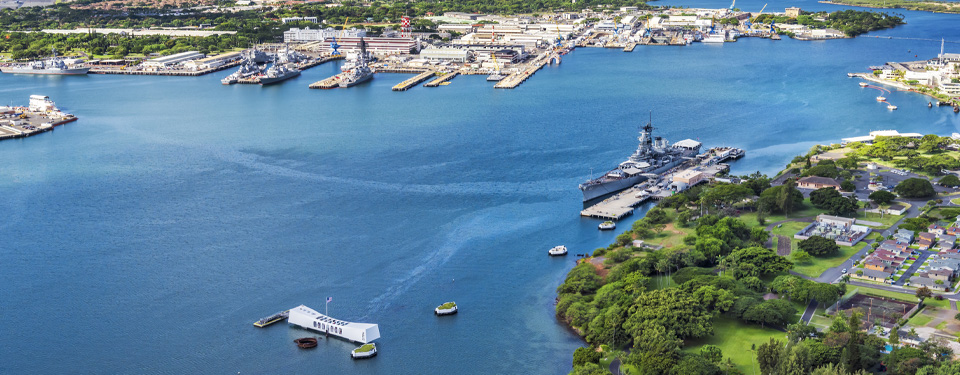Caring For The Land
A Responsible Steward
The proposed project will be in compliance with all applicable permitting processes. As the long-term owner and operator of the project, Ameresco, Inc. is committed to serving as a good steward of the environment and community.
Project facilities will be located on land that is heavy industrial and currently houses two large warehouses, which will be deconstructed by a local recycling non-profit entity, mitigating greenhouse gas emissions.

City Zoning and Land Use Classification
Generally, given the proposed project is located on federal land it is not subject to state or local land use planning or zoning considerations.
City & County of Honolulu Zoning: F-1 (Federal and Military Preservation District)
State Land Use Designation: Urban on federal land
Discretionary and Non-Discretionary Land Use, Environmental and Construction Permits and Approvals
Given the proposed project is located on federal land, these permitting requirements will be addressed through the federal permitting process.
Permits and Approvals
The proposed project will be designed in compliance with permitting requirements, including:
- National Environmental Policy Act (NEPA);
- The Clean Air Act;
- The Clean Water Act;
- Endangered Species Act;
- National Historic Preservation Act; and
- Hawaiʻi Coastal Zone Management Program.
| Permit or Consultation | Agency or Stakeholders |
|---|---|
| National Environmental Policy Act – NEPA | Department of the Navy |
| National Historic Preservation Act Section 106 Consultation | State of Hawai‘i Department of Land and Natural Resources, State Historic Preservation Division |
| Coastal Zone Management Act (CZMA) De minimis acknowledgment | State of Hawai‘i, Office of Planning and Sustainable Development, Coastal Zone Management (CZM) Program |
| Prevention of Significant Deterioration (PSD) or Covered Source Permit (CSP) | State of Hawai‘i Department of Health – Clean Air Branch |
| National Pollutant Discharge Elimination System (NPDES) Permit | State Department of Health, Clean Water Branch |
Preliminary Assessment
Ameresco commissioned a preliminary environmental assessment to assess the existing conditions and resources and the potential impacts of development of the proposed Project. This assessment considered both short- and long-term impacts and the results are summarized below.
The proposed Project site is in an urban environment and habitat is limited to the few trees presently on the site. Nearly all of this site is covered by impervious surfaces. There is a very low probability of threatened or endangered species on either site.
The proposed Project would not result in an incremental change to land use patterns or redevelopment activities. The proposed Project would not lead to secondary or indirect changes to land use and development on O‘ahu as renewable energy is generally a substitute for energy that would otherwise be generated through other means, such as fossil fuels, solar, or wind. Impacts to biological resources or cultural resources are not anticipated, as no sensitive resources are expected to be present within the proposed Project area.
Preliminary impact assessment of the operation of the proposed Project indicates the operational emissions of the generators will not result in hazardous air pollutant emissions greater than major source thresholds, greenhouse gas (GHG) emissions will not impede the state’s GHG goals, and modeled concentrations of criteria pollutants will not exceed the National Ambient Air Quality Standards (NAAQS) and State Ambient Air Quality Standards (SAAQS). Thus, anticipated air quality impacts are not expected to interfere with the attainment of NAAQS/SAAQS or appreciably increase human health risks in areas where sensitive receptors and/or public presence is anticipated.
Short-term construction impacts include those related to increased dust, erosion, and noise. Measures would be implemented to avoid and minimize Project-related construction impacts. Additionally, the proposed Project is not expected to result in any significant cumulative impacts when considered with other known past, present, and foreseeable future actions.

Cultural Resource Impacts
Pearl Harbor is associated with Native Hawaiian and World War II era military resources and sites. The Pearl Harbor Naval Complex has been designated a National Historic Landmark and is listed on the National Register of Historic Places.
Architectural resources near and within the Pearl Harbor National Historic Landmark main base include warehouse buildings, the Marine Barracks and Hale Alii, Makalapa Housing historic management zones, and small-scale rail landscape features. There are three historic buildings that are currently present within the project area, and include:
- Building 244, a storage shed that was constructed in 1943, which has already been determined not significant, and no documentation would be required prior to its removal; and
- Buildings 158 and 159, both General Warehouse structures that were built in 1940 and have been identified as a type of historic resource that can potentially be mitigated through some combination of written and photo documentation, interpretive signage, deconstruction along with reuse or recycling of the warehouse materials rather than demolition, and rehabilitation of other buildings that contribute to the Pearl Harbor National Historic Landmark.
Based on the past studies and the current use of the site today, there is low potential for the identification of significant traditional Hawaiian archaeological sites to exist, and the historic architectural resources are known. The prior studies and current assessment suggest there will not be any cultural or archeological resources that will be affected by the design, development, construction, or maintenance of the project. Upon award of the Project, an additional, more detailed cultural and natural resource impact analysis will be performed to ensure that any and all significant resources are identified prior to design finalization to incorporate any necessary mitigation or relocation activities.